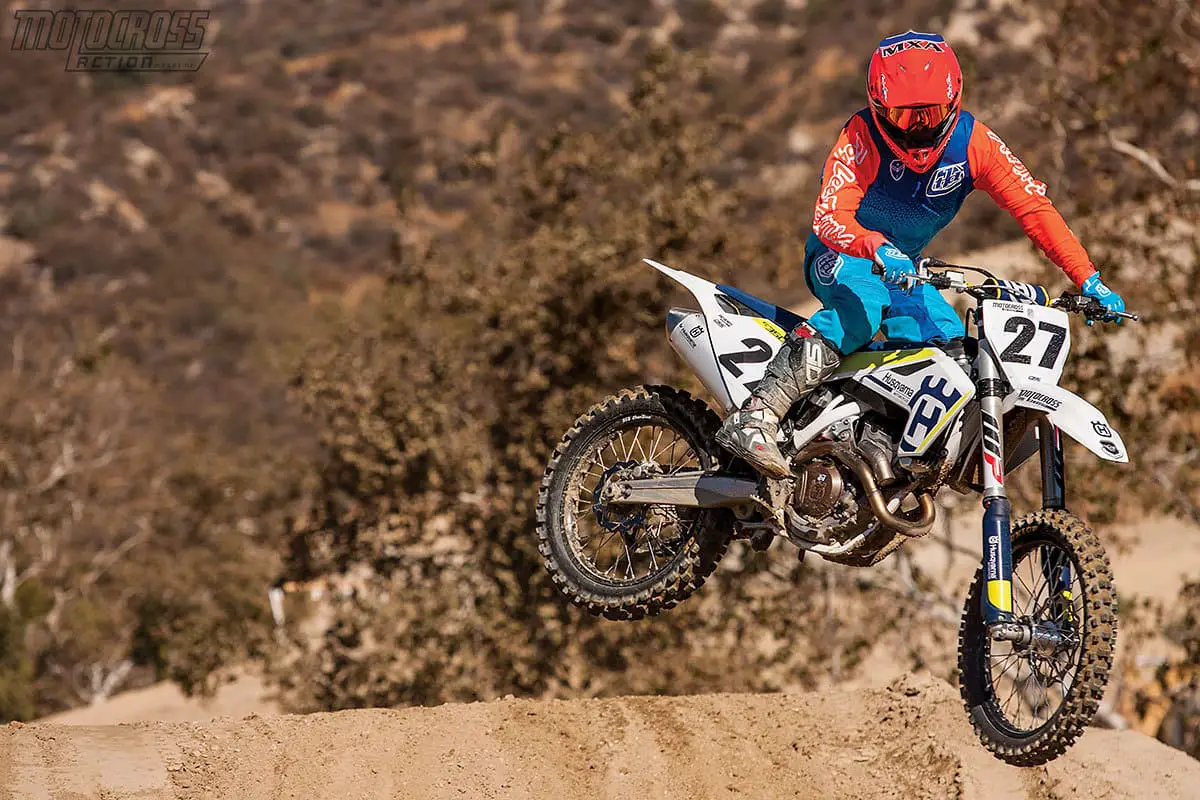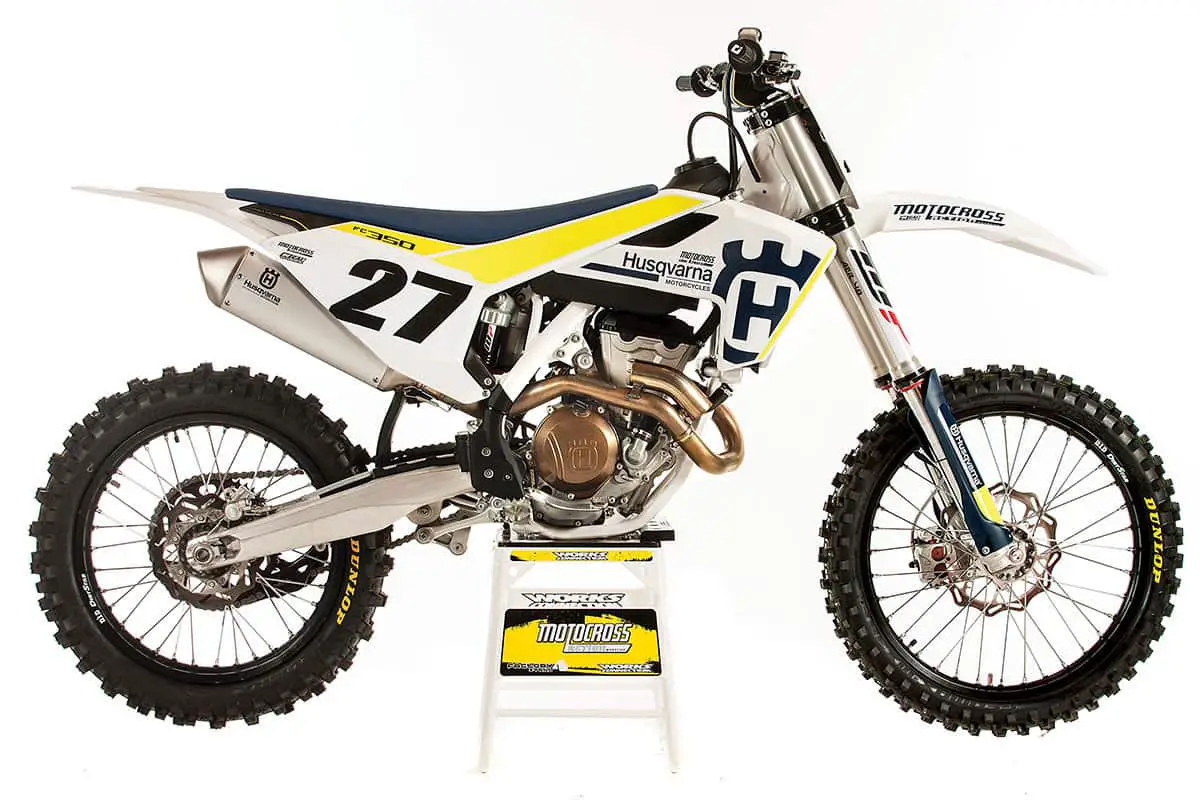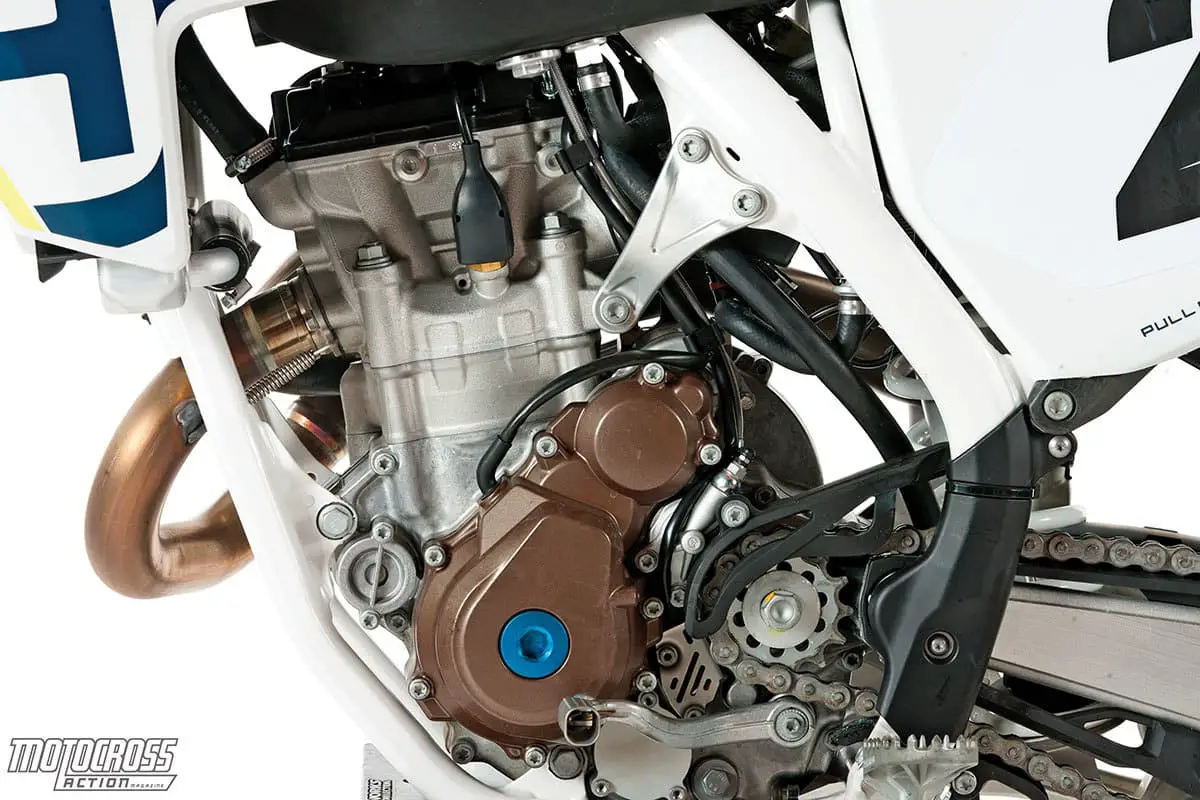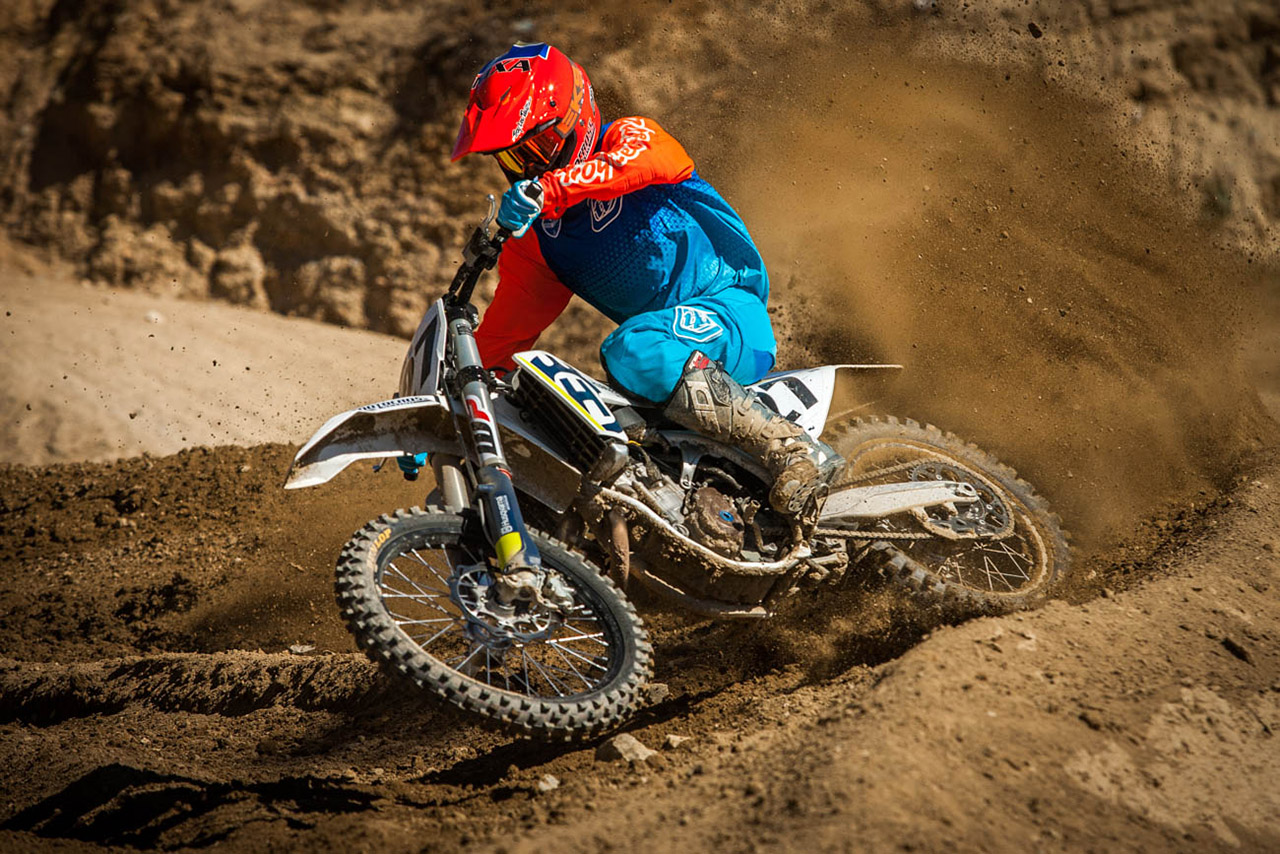MXA RACE TEST: 2017 HUSQVARNA FC350 — THE YOUNGER BROTHER
Click on images to enlarge
 The 2017 Husqvarna FC350 is the younger brother of the KTM 350SXF. There are differences that might make a racer choose one over the other.
The 2017 Husqvarna FC350 is the younger brother of the KTM 350SXF. There are differences that might make a racer choose one over the other.
Q: FIRST AND FOREMOST, IS THE 2017 HUSQVARNA FC350 BETTER THAN THE 2016 FC350?
A: It is important to note that 90 percent of the 2017 Husqvarna FC350 is the same as last year, but the 10 percent that is different is a big deal. The swap from WP 4CS forks to WP AER air forks is a massive step up the evolutionary ladder. Not only do Husqvarna’s new air forks work very well, they are simple to adjust, easier to live with than the complicated Showa SFF TAC forks and Kayaba PSF-2 forks, and they are 3.6 pounds lighter, which means that the 2017 Husqvarna is also significantly lighter. How light? It weighs 221 pounds, which is 12 pounds lighter than a 2017 Honda CRF450 and 19 pounds lighter than the Suzuki RM-Z450.
Q: WHAT OTHER 2017 CHANGES CONTRIBUTED TO THE FC350 BEING A BETTER BIKE?
A: Husqvarna has not stood pat with the FC350. Its engineers have applied all the lessons they learned from the 2016 FC350—at least the lessons they could afford to apply. Here is a quick list of the changes that make a difference.
(1) Spring rates. We had issues with WP’s choice of rear shock spring in 2016. The stock 2016 spring was a 48 N/m unit that was too stiff for anyone under 180 pounds. For 2017, the FC350 gets a 42 N/m spring. This spring rate is more in line with the target weight of the potential buyer. One caveat: If you are over 180 pounds, consider going to a 45 N/m spring. If you are over 200 pounds, look into a 48.
(2) Rear brake. Husqvarna made two changes to the rear brake system for 2017. First, the rear brake pedal is 10mm longer than the 2016 pedal. Every test rider liked this mod. Second, the rear brake pads have a less aggressive compound and thus are less grabby or prone to overheating.
(3) Triple clamps. Husqvarna’s engineers stiffened up the top triple clamp to work better with the AER air forks. To a man, the MXA test riders feel that the steering input on the 2017 is more accurate than on the 2016.

Unlike the Husky FC450 muffler, which has ice cream cone-shaped restrictors in it, the FC350 muffler is straight through.
Q: WHAT 2017 CHANGES TO THE FC350 WERE A PUSH?
A: Not every change is a home run; some are bunts, Texas Leaguers or walks. Husqvarna’s list of changes included some features that the MXA test riders could take or leave. Here is a quick list of the mods that were a push on the tech scale.
(1) One-piece bar mount. Husky says that the new one-piece top bar mount will prevent the twisting that we suffered with last year’s one-piece lower bar mount. Guess what? The bar mounts still twist in a crash.
(2) Map switch. For 2017 the map switch is located on a fancy electronic multi-switch on the left side of the handlebars. The 2017 multi-switch offers two maps (stock and aggressive). Last year’s map switch was a flick-style lever that offered two maps (stock and one option), but the optional map could be changed to aggressive or mellow by moving a dial in the airbox. The electronic switch is cool, because it has lights on it, but it’s not a game-changer.
(3) Launch Control. The launch control mode on the 2017 bike is activated by pressing two buttons on the multi-switch at the same time. This is no mean feat when sitting on the starting line wearing gloves. The old launch control system was activated by flicking the flick-style launch control button back and forth twice. Neither system, 2017 or 2016, allows the rider to blip the throttle while waiting for the gate to drop.
(4) Traction control. The 2017 Husqvarna FC350 has a traction control button on the multi-switch. In truth, we rarely use it. It is too aggressive to use on tracks with loamy dirt, so we only use it on hard-pack tracks—and then we only use it as a replacement for 2016’s mellow map option. Husky’s traction control worked best on hardpacked, rock-hard, muddy or slippery track surfaces.
(5) Head stays. The 2017 head stays are cast aluminum and more rigid than the steel stays of 2016. They look nicer and are 2 ounces lighter.
(6) Torx mania. If you buy a 2017 KTM or Husqvarna, you will need a #15 and #20 Torx wrench. The fork air-bleeder caps are held on with the #20, while the ODI grips are held on with a #15. So, without these two special wrenches, you can’t bleed the forks or change your grips. Last year we could use a Phillips screwdriver on the fork air bleeders and an Allen wrench on the grips.

There is no dedicated airbox cover. Instead, the complete side panel, including the radiator shroud and rear number plate, slide off without tools.
Q: WHAT 15 CHANGES TO THE FC350 WOULD WE LIKE TO SEE IN THE NEAR FUTURE?
A: On every motocross bike there are irritating little glitches that grind your gears every time you run into them. Here is a quick list of things that push our buttons on the 2017 Husqvarna FC350.
(1) Exhaust pipe. On the Husqvarna assembly line, they must put the exhaust pipe on the conveyor belt first and then build the bike around it, because you can’t take the pipe off without taking the shock off—and you can’t take the shock off without loosening the shock linkage, and you can’t loosen the linkage without removing the left-side chain-slider pad. A three-piece exhaust system would solve this problem.
(2) Gas cap. It sticks so tight that sometimes you have to ask strangers to help you remove it.
(3) Sprocket bolts. As tight as the gas cap can get, the sprocket bolts are the exact opposite. We think that the taper on the bolts is different than the taper on the sprocket holes, but even if we are wrong, we have to check the sprocket bolts every race. Unlike the gas cap, they come loose constantly. Never trust that they are tight and you will never have any trouble.
(4) Spokes. The spoke next to the rim lock has a mind of its own—and it is the leader of the pack. When it comes loose, the rest of the spokes follow suit.
(5) Front brake hose. Be very careful when hooking tie-downs onto your handlebars that they don’t crimp the L-bend tube coming out of the front brake’s master cylinder. We would prefer more room between the brake line and the bars to lessen the chance of damage.

(6) Gearing. We don’t hate the stock 50-tooth gearing, because it gives the 350SXF powerband a seamless rheostat delivery; however, with a 13,400-rpm rev limiter and peak power at the top of the chart, half of the MXA test riders preferred to add a tooth to the rear sprocket to get full use out of the high-rpm powerband. Some add two teeth.
(7) Frame guards. We appreciate that Husky put plastic frame guards on its bikes, but the black guards only go halfway up, exposing the white frame paint to excessive wear. Perhaps white plastic guards would work better with the color scheme.
(8) Spacers. There are spacers in the seat-bolt hole and right-side panel that fall out when you remove either of these two bolts. Shouldered bolts or tolerance-fit spacers would have solved this problem.
(9) Tubes. Expect to get flats until you replace the super-thin Pirelli tubes hidden under the Dunlop MX3S tires with something stouter.
(10) Neutral. The Husqvarna shifts perfectly on the track, but when it comes to selecting neutral in the pits, it’s best to get off and use your hand.
(11) Bike stand. When the FC350 is sitting on a bike stand, the front wheel is sitting on the ground. This makes simple maintenance a hassle.
(12) Fork clickers. Turning the compression clicker on the forks is harder than it should be. Would it kill WP to put a larger-diameter clicker on the top of the forks so that it is easier to access?
(13) Cross-bar pad. It has a life of its own. One moto it is rotated forward; the next moto it is rotated back. And, it makes getting to the fork’s Schrader valve difficult.
(14) Fork guards. When WP used the old-school wraparound fork guards, we never suffered any fork-seal issues. Now that KTM and Husky have gone to the front-only-style fork guards, we are changing fork seals on a regular basis.
(15) Airbox. We understand that Husqvarna is focusing on selling enduro bikes, but that’s no excuse for putting a watertight and airtight airbox on its motocross models. Come on, guys; let it breathe.

Q: HOW FAST IS THE 2017 HUSKY FC350?
A: There are no cam, valve, piston or exhaust pipe mods on the 2017 FC350. Mechanically, the 2017 engine is the 2016 engine, save for a mapping change that makes it feel smoother. There is only one way to ride a 350—be it white or orange—and that is flat out. You must rev it to the moon. Getting the most out of the FC350 means that you must rev until the engine hits the 13,400-rpm rev limiter. It makes max power at max rpm. If you don’t bleed it dry, you don’t get all the power it has available.
It may sound intimidating to have to race the FC350 at such high rpm, but this is a really sweet powerband. The ultra-high rev limiter means that you can stay in every gear longer than the competition. While they are shifting, you are pulling. It has the perfect power below peak rpm to master tricky half-throttle corners and the perfect powerband at high rpm for riders who don’t like to shift. One caveat—shift at your own risk. Don’t shift too soon or you will be leaving horsepower on the table.
On a side note, you can make the 2017 Husky FC350 have quicker throttle response and a faster turnover by drilling holes in the airbox.
Q: HOW GOOD ARE THE 2017 WP AER FORKS?
A: Showa and Kayaba have jointly ruined the reputation of air forks. Their Rube Goldberg designs, littered with air valves and clickers, have sent racers scurrying back in time looking for reliable and proven coil-spring forks. And, Honda’s 2017 switch from air to springs might well be the death knell of SFF-TAC and PSF-2 forks. If coil-spring forks don’t kill off Showa’s and Kayaba’s overly complicated designs, then the WP AER air fork will. It is so much better than any previous air fork that it is like the Lone Ranger riding in to save the schoolmarm. Very good forks. Did we just say that about WP forks?

Q: WHAT DO I NEED TO KNOW TO LIVE HAPPILY WITH MY FC350?
A: Here is a quick primer of 2017 Husqvarna FC350 know-how.
(1) Peak power. The Husqvarna FC350 makes 54.75 horsepower, but it makes its peak horsepower at 13,400 rpm. That means that if you shift before peak, you will get less horsepower. Thus, you should never shift.
(2) Battery. In cold weather, you should pre-heat the lithium-iron phosphate (LiFePO4) battery before trying to start the bike. We touch the starter button enough to activate the starter, but not enough to get the bike to turn over. We do this two or three times. Why? Because lithium-iron phosphate batteries get stronger as they get warmer. Then, once we have the battery preheated, we push the choke up (not down) and start the bike. Never grind away at the starter button. If it doesn’t start in a few seconds, stop and start over. For 2018, the FC350 will get a stronger battery to lessen this issue.
(3) Launch control. To activate launch control, you must press the map and TC (traction control) button at the same time. If you do this properly, the EFI light behind the front number plate will flash rapidly. Be forewarned; launch control will only stay engaged for three minutes or until you rev the engine and then let the rpm fall off 30 percent or more. What does that mean? If you engage launch control on the starting line and then blip the throttle or do a burnout, you will no longer be in launch control. And, you have to turn the bike off to re-engage launch control. The best strategy is to wait until just before the board turns sideways, then press the buttons to activate launch control. Once you begin to rev the engine up, be careful not to let the rpm fall off. If you do, you will revert back to whatever map you originally chose.
(4) Fuel filter. Husqvarna installs inline fuel filters in its gas lines. They can be accessed via the quick-release fitting on the fuel line. You can flick the small nylon filter out and check it for debris. It can be back-flushed or replaced. Clogged filters hurt the fuel pressure and flow. Be very careful to make sure that the fuel line clicks back together completely. We have had the quick release pop off because we didn’t get it clicked. When the fuel line pops off, the engine stops almost immediately. Click it!

(5) Shock preload adjustment. When we need to adjust the preload on the rear shock, we do not hit the red shock collar with a hammer. Instead, we turn the shock spring by hand while using a long flat-bladed screwdriver to pry against the frame and the shock collar at the same time. If you hit the nylon shock collar with a hammer and punch, you will deform the notches.
(6) Rear brake-pedal spring. Turn your rear brake-pedal spring around so that the tang on the spring closest to your foot faces inward. If it faces outward, you can hit it with your boot and unhook the spring. We also crimp the tangs once they are turned around to make them fit tight to the pedal.
(7) Ignition cover plug. The small Allen plug on the back of the FC350 ignition covers can leak oil—although not enough to create any major issues, just enough to make a mess. This plug can be sealed with high-temp silicone. The Allen plug doesn’t attach to anything; it is just there to block a hole that was drilled in the case during manufacturing to make an internal oil line make a 90-degree bend.
(8) Dunlop MX3S tires. The MXA wrecking crew loves the MX3S (previously called MX32) tires that come stock on the 2017 Husqvarnas, especially the front in comparison to the MX52 that was OEM equipment in 2016. But, be forewarned, if you push the MX3S front out of its intermediate terrain, you will begin to lose side knobs on the front tire. Oh, don’t get us wrong; it works well on hard terrain, but not for long.

Q: WHAT DID WE LIKE?
A: The like list:
(1) Handling. This is the bike that all other bikes need to be compared to. It’s a dream to ride.
(2) Hydraulic clutch. If you’re a clutch abuser, this clutch can take a beating without whimpering.
(3) Weight. You have to be impressed by the 221-pound weight. This is an impossible dream achieved with a battery and electric starter.
(4) Powerband. Even though the MXA wrecking crew thinks that a 375cc, 380cc or 400cc displacement would come closer to fulfilling the dream of a mid-size Open-class bike, the FC350 is the ultimate expression of a 250 on steroids.
(5) Hour meter. Kudos to Husqvarna for putting an hour meter on its bikes at the factory—and saving us the trouble.
Q: WHAT DO WE REALLY THINK?
A: If you are thinking of moving up from a 250 or down from a 450, there are only two 350cc choices—the KTM 350SXF or Husqvarna FC350. First introduced by KTM in 2011, the 350 concept has taken seven years to come to fruition. Once a novelty bike, the 350 is now the ultimate Vet bike, and it’s rapidly becoming the first choice for professional practice riders. What makes the 2017 350 such a good bike is the addition of WP AER air forks. When you combine these forks with the amazing electric starter, bulletproof hydraulic clutch, creative air filter, awesome brakes, superb handling, 54 horsepower and value in every part, this bike should be on the wish list of every racer over the age of 30.
MXA’S HUSQVARNA FC350 SETUP SPECS

This is how we set up our 2017 Husqvarna FC350 for racing. We offer it as a guide to help you find your own sweet spot.
WP AER FORK SETTINGS
The air pressure on every AER fork varies from Husqvarna model to Husqvarna model. The TC125 uses 125 psi. The TC250 has 148 psi. The FC250 and FC350 come with 154 psi, and the FC450 is set at 156 psi. But, don’t think that you are locked into those recommended numbers. MXA test riders’ air-pressure settings vary from 135 psi to 160 psi—and slower riders have lowered the oil height by 10cc to get the forks to feel even plusher. These are incredibly tunable forks, so don’t be afraid to play with them. For hardcore racing, we recommend this fork setup on the 2017 Husqvarna FC350 (stock specs are in parentheses).
Spring rate: 140 psi (154 psi)
Compression: 20 clicks out
Rebound: 15 clicks out
Fork-leg height: Third line
Notes: Slower or lighter riders might have to lower the oil height in the damping leg by 10mm or more to get full travel. Additionally, we check the air pressure between motos to ensure that the ambient temperature hasn’t raised our favorite settings. It is important to bleed the outer chamber constantly, which is accessed via a 10mm hex head or #20 Torx. Even if you own a #20 Torx, don’t use it on the air side, because it strips out easily.
WP SHOCK SETTINGS
Last year we swapped all of our 48 N/m springs for the lighter 45 N/m springs from the FC250. For 2017 Husqvarna is lowering all of its motocross bike spring rates, which means that the 2017 FC350 will have a 42 N/m spring stock. If you are around 180 pounds, you might want to go to a 45 N/m spring. If you are over 200 pounds, you will probably want to return to the 48 N/m spring. For hardcore racing, we recommend this shock setup for the 2017 Husqvarna FC350 (stock specs are in parentheses).
Spring rate: 42 N/m
Race sag: 105mm (110mm)
Hi-compression: 1-3/4 turns out (2 turns out)
Lo-compression: 15 clicks out
Rebound: 10 clicks out (15 clicks out)
Notes: We turned the high-speed compression damping in a little to lessen G-outs and ran a touch more rebound than the recommended setting. Additionally, we set the sag at 105mm instead of the WP-recommended 110mm.








Comments are closed.